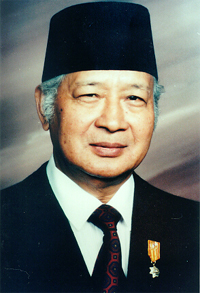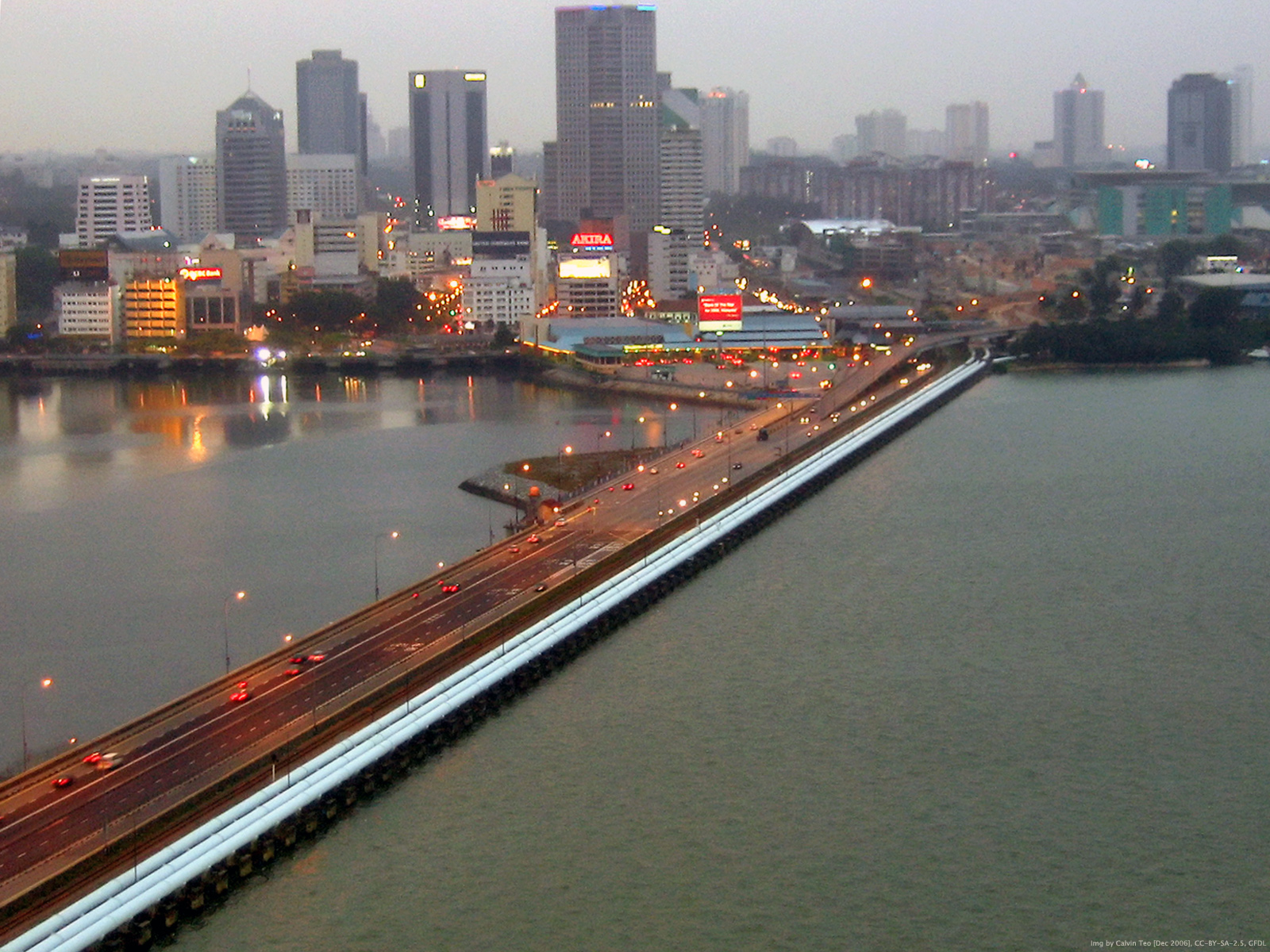Singapore's The Business Times has a profile of a relatively unknown Indonesian tycoon Chairul Tanjung, who is a banker and media owner. What is interesting is that while many bigger Indonesian names collapsed during the Asian financial crisis in 1997/1998, he emerged as a new kid on the block then.
Of course, business in Indonesia is deeply intertwined with politics. And political fortunes can often change suddenly and make a big difference in the land of volcanoes.
Man with the Midas touch
Among business circles in Indonesia, he is hailed as one of the fastest-rising stars, with close links to the new political elite. Yet little is known about the media-elusive tycoon. In his first extensive interview in any media, Chairul Tanjung grants LAUREL TEO a rare glimpse
 THERE is no such thing as second-best for Chairul Tanjung. His six-year-old Trans TV station may not boast Indonesia's biggest market share nor the highest ratings, but it claims the heftiest profits.
THERE is no such thing as second-best for Chairul Tanjung. His six-year-old Trans TV station may not boast Indonesia's biggest market share nor the highest ratings, but it claims the heftiest profits.
Likewise, his Bank Mega is not the largest, but its earnings growth is among the handsomest in the financial industry. Last year, Indonesia's No. 12 bank, with assets of US$4 billion, raked in US$63.7 million in pre-tax income for the first nine months, nearly three times as much as in the previous year.
The bank also boasts one of the most sought-after credit cards in town. 'All the top bankers carry a Bank Mega card in their wallets,' he proffers this morsel of information with pride.
It's an open secret that the card offers some of the best discounts for an assortment of top-end fashion and dining outlets, a number of them managed under the lifestyle arm of Mr Chairul's sprawling CT Corporation, previously known as the Para Group of companies.
In just over two and a half decades, he has amassed a wealth estimated at US$450 million to US$565 million, catapulting him into the 18th spot in the 2007 rankings of Indonesia's richest by Forbes Asia magazine, and 15th in Globe Asia's rankings.
No wonder the local media dub him the Golden Boy. Just 45, his knack for making profit is near legendary.
As he folds his lanky 1.83 metre frame into an armchair in his office, he tells BT over a two-hour interview how he learnt to turn dust into gold.
Despite his perpetually tight schedule, he appears relaxed, speaking in his characteristically affable manner as he takes his time delving into details. But for all his languid charm and easy manner, he is methodical in his narration, hardly brooking any interruptions.
'I'll tell you later,' is his firm response, should you jump ahead of his narrative or try to veer off course with premature questions.
He had a humble start. Born on June 18, 1962, he was the second of six sons. A seventh child - a girl - died while still a child.
His journalist father, a Batak from North Sumatra, had migrated to Jakarta early in life and married a Sundanese of West Java origins. While life for the young Chairul was not the harshest, neither was it a bed of roses.
By the time he enrolled in a dentistry course at the University of Indonesia in 1981, his father's meagre salary could stretch no further, and the teenager had to figure out how to pay his own way through school. Thus was launched a career in business. 'Actually, at that time I didn't see it as business at all. It was not to make money, just to survive,' he recounts matter-of-factly.
Out of sheer desperation, the college freshman hit upon an idea. 'One study guide cost 500 rupiah at the photocopy shop. But I knew a friend with a hand printing press that could do it for 150 rupiah. See, networking is very important in business,' he exhorts with a merry chortle.
The pair teamed up to sell copies at 300 rupiah each, double the cost price, but still cheaper than the market rate.
The young Chairul made his first 15,000 rupiah - a paltry sum no more than a couple of dollars, but priceless in terms of a mental boost. 'That was when I realised: it's much harder to make your first dollar than your second million. With the confidence of that first dollar, it's much easier to continue,' he muses.
From manuals, he progressed to hawking T-shirts, stickers, bags and even materials for practicals. By his fourth year, he was the envy of his class. He had purchased his first car - an eight-year-old Honda Civic.
'Oh, at that time, I was very proud of it. I drove all my friends to Pasar Baru - something like your Orchard Road in the old days,' he says with a wry chuckle. 'Most important rule, they must wear sunglasses . Young man, want to look cool,' he quips, showing he is not above poking fun at himself.
Along the way, he found time to run for and win the student government presidency. In 1984, the competitive overachiever also beat hundreds of thousands across the country to pick up a prestigious national award as the top all-round college student.
When he graduated in 1987, Mr Chairul was faced with two choices. 'I could practise dentistry in government service. The salary won't be high, but I'd get a house and a comfortable living. But it won't be enough to support my parents and four younger brothers. They were still studying. So I continued with business.'
In this and many other decisions, it becomes clear that he is guided by a ruthlessly pragmatic maxim: 'What I like or dislike is irrelevant. There's no meaning 'like'. It's about what needs to be done.'
Going solo
He set up a shoe manufacturing business with two friends and was soon churning a tidy profit. But by 1994, he was hungry for new challenges. He sold his shares to his partners to venture solo into finance.
'At that time, I was still a nobody. But that was the happiest time of my life. I was not so busy, had enough money, and still had my privacy,' he recalls almost ruefully.
A chance came up a year later to buy over Bank Karman - a relatively modest outfit. Still only in his mid-30s at that time, he grabbed it and renamed it Bank Mega.
Then came the Asian financial crisis, which finally thrust his business into the big league. While even once indomitable conglomerates began collapsing one by one, Bank Mega not only weathered the storm, but chalked up a record profit in 1998. It multiplied earnings by a staggering 20 times to 240 billion rupiah - a sum that could have bought out Indonesia's No. 1 car-maker Astra at that time, Mr Chairul recounts gleefully.
'But I didn't take a single rupiah of the money. Everything was injected back into the bank to enlarge the capital base. That's how I grew the bank,' he says.
He credits the financial crisis with freeing up Indonesia's business sector. 'Before the crisis, Indonesia's business map was fixed. At the very top, you had a layer of the largest conglomerates. Nobody could touch them. Nobody had any hope of catching up. There was simply no opportunity.'
But the fatal combination of the crisis and Suharto's downfall dissolved the old patronage system between the political elite and their business cronies. As monopolies crumbled and the former business bigwigs retreated to lick their wounds, the field lay open for newcomers. 'It was an extraordinary opportunity for us to grow,' recalls Mr Chairul.
One major sector thrown open was TV broadcast, previously dominated by the Suharto family.
Mr Chairul secured a licence and introduced a new business model. 'When I first built my TV station in 2001, everyone said I was crazy. Because I constructed all the production facilities and put everything in one building,' he says. The convention in the Indonesian TV industry is for stations to buy external programmes and make money from selling ad-time. Mr Chairul insisted, however, on having most of his Trans TV programmes produced in-house, allowing him to control the content and cost structure.
He has the last laugh. Trans TV is now peerless in the earnings chart. Its profit, reveals its proud owner, is more than double that of runner-up RCTI, even though the latter claims the largest audience share.
In 2006, Mr Chairul's media empire expanded with the acquisition of 55 per cent of the loss-making TV 7, previously controlled fully by Jakob Oetama's Gramedia group.
'Five years they managed, five years of losses. Pak Jakob had to pump in 200 to 300 billion rupiah every year,' he says. 'Pak' is a respectful Indonesian term of address for men.
Within a year of the takeover, TV 7 - now renamed Trans 7 - leapt into the black for the first time. 'The profit is big enough, something like a reversal of the losses. Just change the 'minus' to 'plus',' says Mr Chairul with a grin.
On the political front his links are impeccable. He is widely known to be in an ambitious joint venture with Vice-President Jusuf Kalla. Both clans are developing a 12.7-ha integrated mega theme park, resort and shopping haven in Makassar, capital of South Sulawesi and the hometown of Mr Jusuf.
Just on Tuesday, Mr Chairul and his wife joined the VP on a three-day umrah or minor pilgrimage to Mecca. The trip came at the personal invitation of the Saudi King. Earlier in October, Mr Chairul reportedly shuttled to East Java with the President to visit a village under threat from a volcanic eruption.
His stunning success and new political links stand in stark contrast to his modest beginnings, which has led to mutterings in some circles. Another man of clout is now sometimes spotted by his side - Anthony Salim, who heads the powerful Salim Group. Mr Chairul is clearly aware of the gossiping about him, and confronts the issue good naturedly. 'It's OK, no problem,' he says in his easy drawl.
Both the VP and President Susilo Bambang Yudhoyono got chummy with him long before they became political top brass. As fellow businessmen, he and Mr Jusuf had hobnobbed for years on the commercial circuit, he explains. Dr Yudhoyono became a friend when he sat on the board of advisers for the National Badminton Association while Mr Chairul was heading the sports body several years ago.
No government dealings
'We are just friends. Up until now, I have not done a single business with the government. Not a single contract,' he asserts, in an attempt to register that he was not in the habit of seeking or receiving political kickbacks.
Neither does he harbour any political ambition. Sweeping aside rumours of a Golkar affiliation, he says he is not a member of any political party.
Turning to the Salim rumours, he clarifies that he is a partner with, rather than proxy for, Anthony Salim. The pair are 50-50 co-investors in Grandiflora, a vehicle that controls more than a quarter of the shares in Singapore-listed healthcare company Asiamedic.
Their ties go back to the Asian financial crisis. When the Salims' flagship Bank Central Asia (BCA) ran into trouble a decade ago, it was Mr Chairul's Bank Mega that bailed out BCA with some crucial lending, he says, adding that he also lent funds to a couple of other Salim outfits.
The secret to Mr Chairul's near-perfect track record harks back to the solid grounding from his days in the shoe business, what he calls his industrial training.
He works hard, runs a tight ship in operations, and takes an extremely patient and long-term view in investment. 'In industry, you cannot collect profit immediately, but must always invest it back into your business, upgrade technology,' he says.
The self-confessed workaholic is stumped when asked to list his hobbies. Outside of work, he spends what free time he has with his wife, 11-year-old daughter and five-year-old son.
What about golf? 'Too many holes, too many balls, too many sticks.' His business associate translates this later as 'No time.'
But lest you pigeonhole him as someone who is driven purely by money-making, Mr Chairul reveals an idealistic core that reminds you of the reasons he became a student leader.
It was his faith in his country that kept him here during the financial crisis, a faith that was ultimately rewarded, he says.'For me, I'm always optimistic about this country. That's why I never left.'
Other bank owners panicked and fled to places like Singapore or Hong Kong, leaving bank managers and ground-level staff rudderless. Their panic sparked a mass exodus of customers.
At Bank Mega, however, Mr Chairul as head honcho rallied the troops and got the staff to work doubly hard at drawing customers and collecting deposits. 'Other banks were drained, but our bank kept collecting. And we had no competition at that time,' he recounts.
His nationalistic passion has led him to chair the Indonesia Forum Foundation (YIF), a grouping of the nation's top academics, bureaucrats and business leaders. Last year the YIF produced a Vision 2030 for Indonesia. Among the targets: Indonesia is to become a top five economies by the year 2030, and there will be at least 30 local companies in the Fortune 500 list.
While some critics have panned this as an ambitious pipedream, Mr Chairul prefers to see it as idealistic goal-setting. In fact, by May this year, the YIF is following up with an action plan for the mission.
For he lives by this creed: 'We have to be the best player. Otherwise, there's no need to play.'
Next stop, Singapore
CHAIRUL Tanjung has earmarked Singapore as the regional hub for the expansion of his CT Corporation. Teaming up with the Economic Development Board, he will start by introducing a series of luxury furnishing and accessories brands to Singapore.
The Trans Living group has about 10 brands currently, holding their distribution rights for the whole of Asia, not just Indonesia. It has already set up a showroom in Singapore for Baker furniture, an exclusive top-of-the-line handcrafted collection with clients drawn from the world's jet-setting crowd. Familiar names include Cindy Crawford and Tom Cruise. Other upcoming brands include Armani Casa, Molteni & C, as well as Donald Trump.
Trans Living falls under Trans Corpora, one of the three distinct arms of parent company CT Corporation. A second arm is CT Global Resources, a new venture started just last year to explore palm oil cultivation and agribusiness research.
The final arm, Mega Corpora, groups together all the financial services, such as Bank Mega, Bank Syariah Mega, and insurance and motorcycle-financing units.
Of the three arms, Trans Corpora is the most complex, as it covers a broad range of media, fashion, F&B, travel and property interests grouped into three divisions. Upcoming projects in Indonesia include a fully air-conditioned theme park the size of five football stadiums, as well as a luxury airline. Mr Chairul says fashion and F&B will follow the furnishing business soon in coming to Singapore. The idea is to grow these from Singapore to Hong Kong, China and other major Asian destinations.
Business aside, Mr Chairul is also planning to move his children to Singapore next year for their studies. He and his family are already permanent residents here, says the 45-year-old, who recently purchased a property in the Nassim Road area.
Ever the far-sighted man, he has already started his 11-year-old daughter and five-year-old son on Chinese lessons. Word is that he is eschewing the usual Ivy League route for his elder child, aiming instead to send her to the University of Beijing.



















